There will be days when you want to make a recipe, but you don't have all the ingredients needed and you don't want to run out to the store for just one item. Spoiler alert: in a baking recipe, you can't just eliminate an ingredient if you don't have it. This is where baking ingredient substitutions come in handy.
Here's a guide to making substitutions in baking recipes. For those who don't have years of baking experience, nor a background in baking science, I recommend only making 1 substitution at a time per recipe. Too many substitutions can cause problems and the results might not be as great as you expect.
Also note that, with any of the substitutions listed here, you can't expect to get the exact same outcome as if you followed the recipe word-for-word. There's inevitably a little trial and error that has to go into baking substitutions until you get to the results you want.
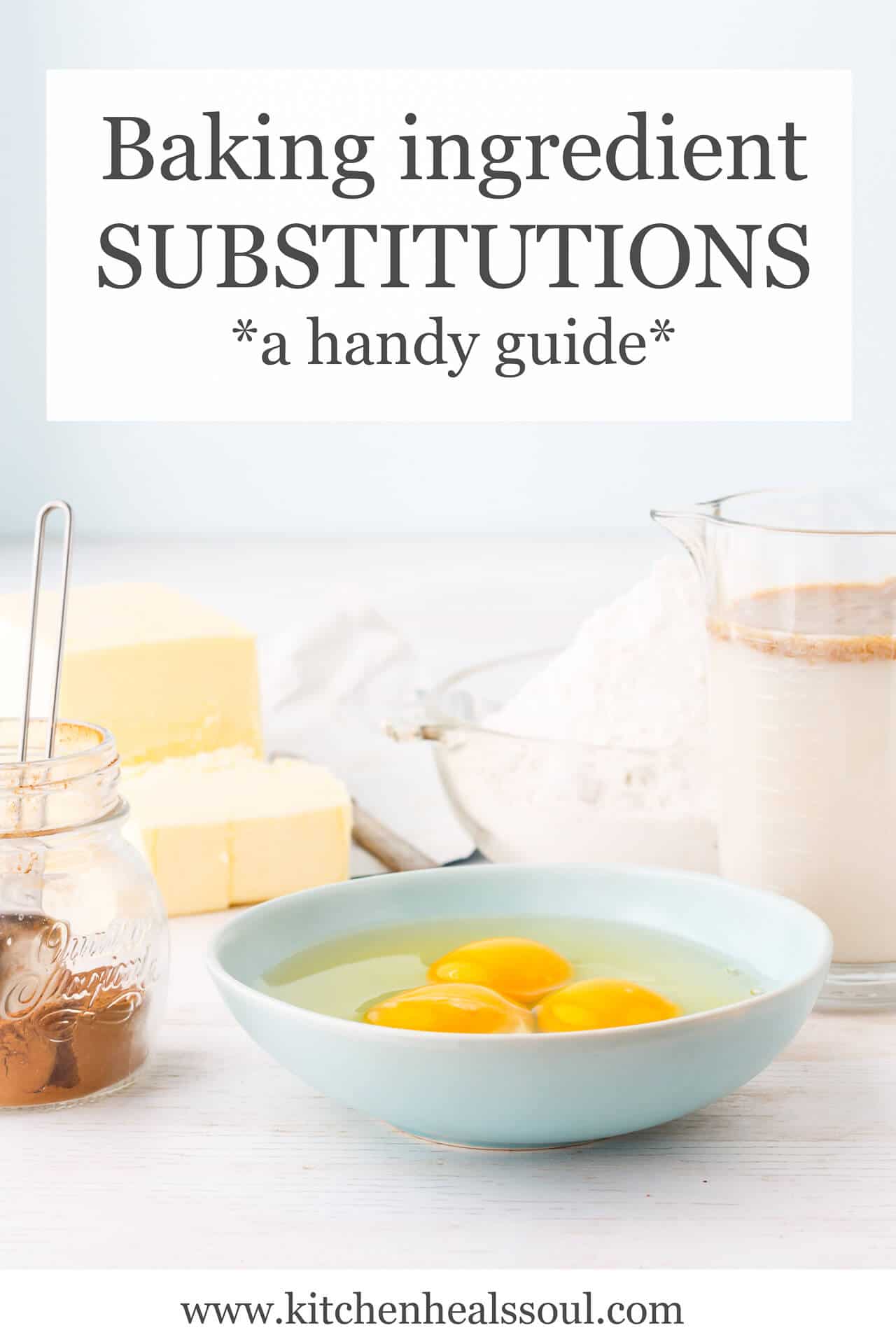
Jump to:
Fats
The average butter sold at most grocery stores in North America is roughly 80 % fat, while oils (like canola oil, coconut oil, or vegetable oil) are 100 % fat. Many will recommend to replace one fat with the same amount of another in a 1-to-1 substitution. This can work but when trying to substitute oil for butter, or butter for oil, the extra fat in oil and the lower fat content of butter will have an impact on the texture of the baked goods.
More fat will create a more tender product that may be more delicate and prone to crumbling, while less fat may create a more dry baked good. Also, when taking a recipe made with softened butter that is mixed with sugar via the creaming method and replacing the butter with oil, this will have an impact on the airiness of the baked goods as you can't whip the oil with the sugar to incorporate air into the mixture. These are things that you need to know before proceeding with the following substitutions.
Butter
If you want a substitute for butter, your best bet is oil. Remember that oil is liquid at room temperature so you won't be able to use the creaming method with oil to incorporate air into the mixture. That may lead to denser baked goods at the end.
- Replace 250 mL (1 cup) of unsalted butter with 190 mL (¾ cup) of oil.
Oil
Remember that butter is solid at room temperature, which means that while it's easy for you to whisk oil with sugar and other liquids in a recipe, for example, it won't be quite as easy if you replace the oil with butter unless you melt the butter. Plus, melted butter may become solid when mixed into batters or doughs that are too cold so you need to be mindful of temperatures when working with butter:
- Replace 190 mL (¾ cup) of oil with 250 mL (1 cup) of unsalted butter. If working with eggs, make sure to let the melted butter cool before incorporating it with the eggs to avoid partially cooking the eggs at this stage.
Vegan butter
Vegan butter is a dairy-free butter substitute made from vegetable oils that are mixed with water, salt, flavour agents, and the mixture is combined into a butter-like paste with the help of emulsifiers. Be very careful to read the ingredients of the vegan butter you have to verify if it's salted. You may need to reduce or eliminate the salt from your recipe if it was written with unsalted butter!
Vegan butter has the same water content as regular butter and is meant to replace butter, cup-for-cup, in most recipes. I've used it in cookies like these clementine snowball cookies.
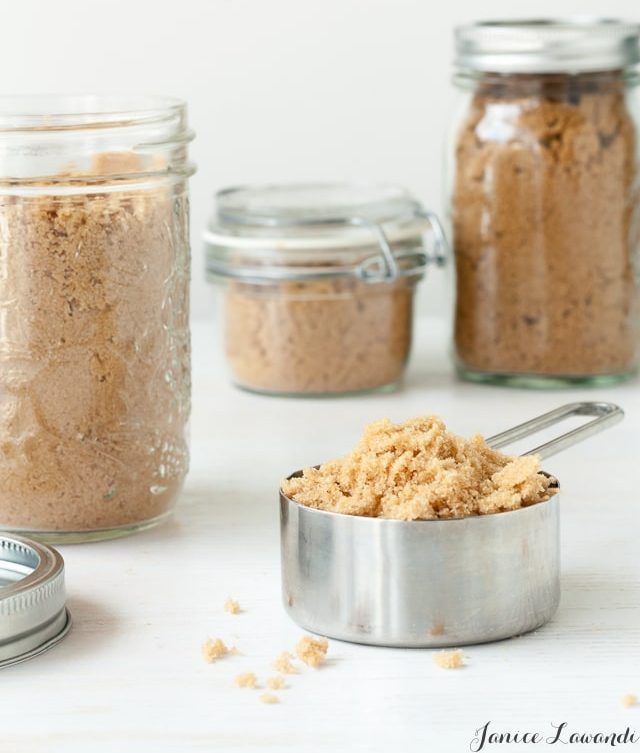
Sugar
Sugar is essential in baking and it actually counts as a wet ingredient, even though it looks like a dry ingredient. In the creaming method, butter and sugar are whipped together to incorporate and trap bubbles of air, lightening the mixture and leading to airier baked goods. Sugar also helps baked goods retain moisture, which means they will store better and last longer. For these reasons, eliminating sugar from most recipes isn't an option you should consider. Even reducing the quantity of sugar isn't ideal without having a big impact on baked goods.
Organic cane sugar vs granulated sugar
I've seen a lot of people push cane sugar over granulated sugar by claiming cane sugar is better for you, but they are essentially the exact same thing, so don't be fooled! Sugar is sugar and both are sucrose, regardless of if it's white granulated sugar or "organic" cane sugar. These two sugars are interchangeable in any recipe.
A few things to keep in mind when baking with honey instead of granulated sugar
- honey is a liquid, so you may have to reduce the quantity of other liquids in your recipe, or if there aren't any liquids in the recipe, increase the flour (add an extra 1 tablespoon of flour for every ¼ cup of honey added)
- honey is high in fructose, which is sweeter than sucrose. So honey is sweeter than granulated sugar. This means you may want to reduce the amount of honey you add if you want to achieve the same level of sweetness as a recipe with granulated sugar
- honey can cause browning more rapidly when baking, so you may want to reduce the oven temperature by 25 ºF. Recipes sweetened with granulated sugar that are baked at 350 ºF should be baked at 325 ºF when using honey.
A few things to note about maple syrup and molasses in baking
- maple syrup and molasses are both liquid, so you may have to reduce the quantity of other liquids in your recipe when replacing sugar with either of these. Or if there aren't any liquids in the recipe, increase the flour (add an extra 1 tablespoon of flour for every ¼ cup of maple syrup or molasses added)
- maple syrup is mostly sucrose, just like granulated sugar, so it's as sweet. This means you can substitute one for the other, cup for cup.
Granulated sugar or cane sugar
Replace 200 grams (1 cup) granulated sugar (or cane sugar) with either of the following
- 200 grams (1 cup) of caster sugar (also known as super fine sugar or special fine sugar)
- 200 grams (1 cup) of brown sugar (light or dark doesn't make a difference but these will impart some caramel colour to baked goods, as well as some extra flavour)
- 190 mL (¾ cup) of honey
- 250 mL (1 cup) of maple syrup
Brown sugar
Replace 200 grams (1 cup) of brown sugar with either of the following
- 200 grams (1 cup) of caster sugar (also known as super fine sugar or special fine sugar)
- 200 grams (1 cup) of granulated sugar or cane sugar
- 190 mL (¾ cup) of honey
- 250 mL (1 cup) of maple syrup
Maple syrup
Replace 250 mL (1 cup) of maple syrup with either of the following
- 200 grams (1 cup) of caster sugar (also known as super fine sugar or special fine sugar)
- 200 grams (1 cup) of granulated sugar or cane sugar
- 200 grams (1 cup) of brown sugar (light or dark doesn't make a difference but these will impart some caramel colour to baked goods, as well as some extra flavour)
- 190 mL (¾ cup) of honey

Honey
Replace 250 mL (1 cup) of honey with either of the following
- 270 grams (1 ⅓ cups) of caster sugar (also known as super fine sugar or special fine sugar)
- 270 grams (1 ⅓ cups)of granulated sugar or cane sugar
- 270 grams (1 ⅓ cups) of brown sugar (light or dark doesn't make a difference but these will impart some caramel colour to baked goods, as well as some extra flavour)
- 333 mL (1 ⅓ cups) of maple syrup
Interestingly, you can swap honey for molasses, volume-for-volume. A great example of this is in these matcha gingerbread cookies. The recipe is almost identical to the classic gingerbread cookie cutouts, but it's sweetened with honey instead of molasses.
Liquid glucose
Glucose is an ingredient use in many of the Milk Bar recipes (like the Milk Bar birthday cake). Since glucose is not as sweet as light corn syrup and since corn syrup is more fluid:
- replace 250 mL (1 cup) of liquid glucose with 125 mL (½ cup) of light corn syrup. Basically use half the amount of corn syrup.
Corn syrup
Since light corn syrup is sweeter than liquid glucose and more fluid:
- replace 125 mL (1 cup) of light corn syrup with 250 mL (1 cup) of glucose. Basically use two times more glucose.
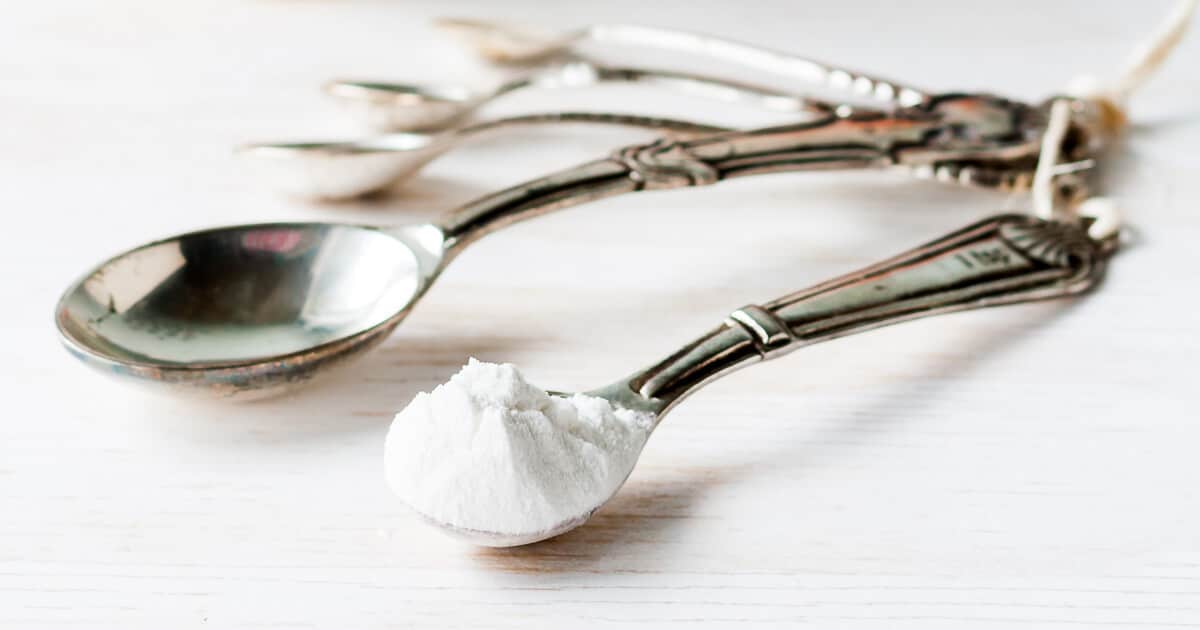
Chemical leaveners
Chemical leaveners are part of the family of ingredients known as leavening agents, which are added to recipes to help your cakes, cookies, and breads rise. These include baking powder and baking soda.
Baking powder
Baking powder is a chemical leavener that helps your cakes rise. Recall that you should be using 5 mL (1 teaspoon) baking powder for every cup of flour in your recipe.
- Replace 5 mL (1 teaspoon) of baking powder with 1.25 mL (¼ teaspoon) baking soda. Note for this substitution to work, you will also have to add an acid to your recipe. For example, if the recipe calls for 5 mL (1 teaspoon) baking powder and 250 mL (1 cup) milk, replace with 1.25 mL (¼ teaspoon) baking soda + 250 mL (1 cup) of buttermilk.
- Replace 5 mL (1 teaspoon) of baking powder with 1.25 mL (¼ teaspoon) baking soda + 2.5 mL (½ teaspoon) cream of tartar (which is an acid, so you don't have to worry about making other changes to your recipe!).
Baking soda
Recall that you should be using 1.25 ml (¼ teaspoon) of baking soda for every cup of flour in your recipe.
- Replace 1.25 mL (¼ teaspoon) baking soda with 5 mL (1 teaspoon) baking powder. Note that if you make this substitution, you will have to adjust the acids in the recipe. For example, if using baking powder instead of baking soda, replace buttermilk with milk.
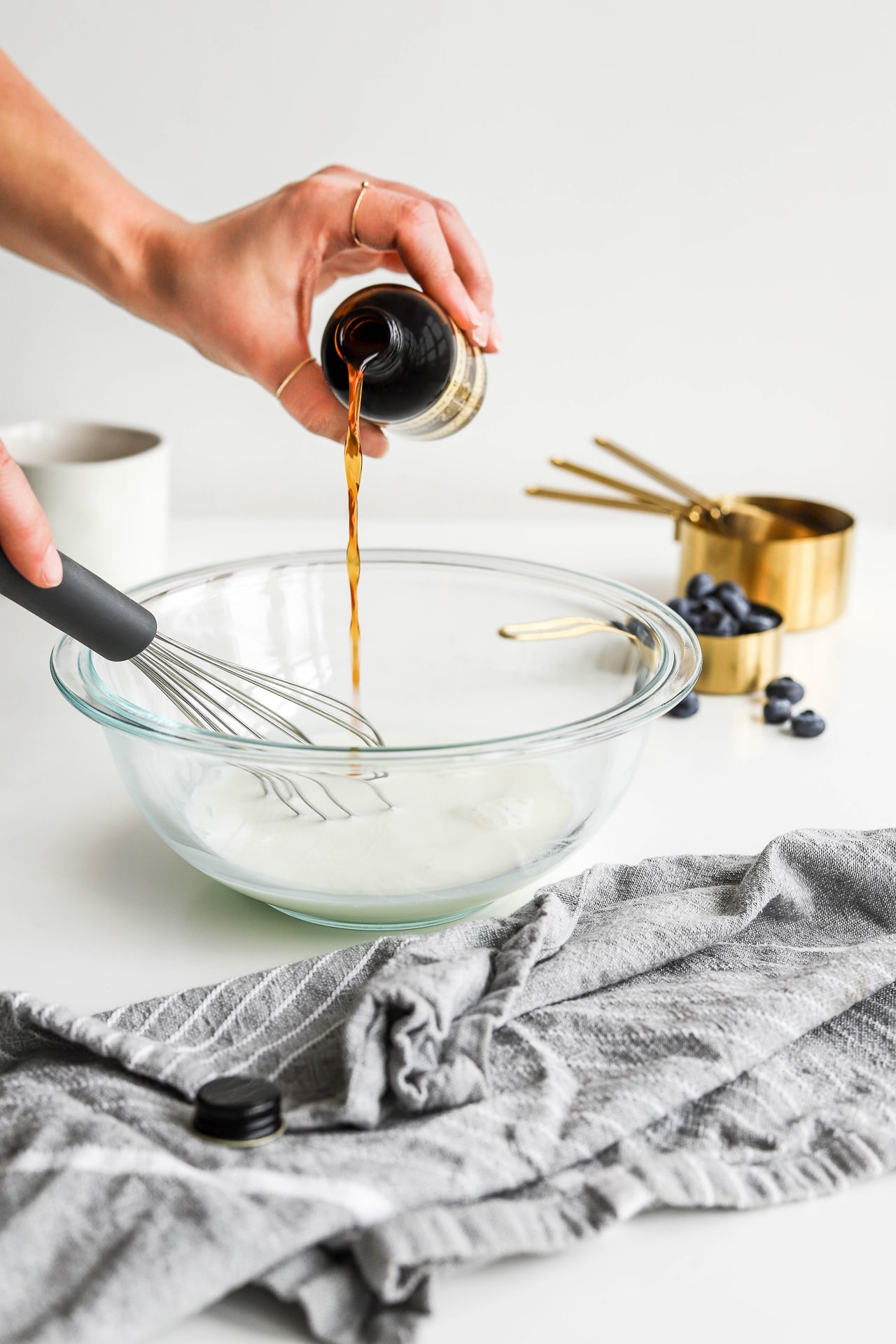
Dairy products (other than butter)
When making dairy substitutions, it's very important to think about the percentage of fat in the dairy product that you want to replace. Don't replace a full-fat dairy product with a low-fat dairy product and expect the same outcome.
It's also important to recognize which dairy products are acidic so that you can replace an acidic dairy product with another acidic dairy product.
Sour cream
Sour cream has a pH around 4, which means it's also an acidic dairy product. Recipes with sour cream, for example cake batters, will feature both baking powder and baking soda, to ensure that the batter has enough "rising power" as it bakes to open the crumb and lead to a more tender, lighter cake.
- Replace 250 mL (1 cup) of full-fat sour cream (14 % fat) with 250 mL (1 cup) of plain, unsweetened full-fat Greek yogurt (9–10 % fat)
- Replace 250 mL (1 cup) of low-fat sour cream ( 1 % fat) with 250 mL (1 cup) of plain, unsweetened low-fat Greek yogurt (2 % fat)
- Replace 250 mL (1 cup) of full-fat sour cream (14 % fat) with 250 mL (1 cup) of crème fraîche (35 % fat) — note this will lead to a richer baked good because crème fraîche has a higher fat content, which may lead to more tender baked goods but also more delicate as the extra fat may disrupt the gluten network.
- In some recipes, you may be able to get away making your own sour cream, just like you would make your own buttermilk, by mixing 250 mL (1 cup) of cream with 15 mL (1 tbsp) vinegar. This worked in the vanilla cake with milk chocolate frosting.
Yogurt
Yogurt has a pH somewhere between 4 and 4.5, depending on the brand, so it is an acidic dairy product. This means that you should replace it with another acidic dairy product if you want to make a good substitution that won't negatively impact your recipe.
Greek yogurt and plain yogurt
Greek yogurt has less water than regular plain yogurt, so swapping one for the other can lead to problems given the difference in water content. Still in some recipes it is possible
- Replace 250 mL (1 cup) of plain, unsweetened full-fat Greek yogurt (9–10 % fat) with 250 mL (1 cup) of full-fat sour cream (14 % fat)
- Replace 250 mL (1 cup) of plain, unsweetened low-fat Greek yogurt (2 % fat) with 250 mL (1 cup) of low-fat sour cream (1 % fat)
- Replace 250 mL (1 cup) of plain, unsweetened full-fat Greek yogurt (9–10 % fat) with 250 mL (1 cup) of crème fraîche (35 % fat) — note this will lead to a richer baked good because crème fraîche has a higher fat content, which may lead to more tender baked goods but also more delicate as the extra fat may disrupt the gluten network.
Buttermilk
Buttermilk sold at grocery stores is usually fat free and an acidified dairy product that has been cultured (meaning inoculated with good bacteria, just like yogurt and sour cream). The pH of buttermilk is usually around 4.5. If you don't have buttermilk, you can use the following substitutions as a guide and replace 250 mL (1 cup) of cultured buttermilk:
- 15 mL (1 tablespoon) of lemon juice, cider vinegar, or white vinegar placed in 1 cup liquid measuring cup and fill to 250 mL (1 cup) with milk (you can use fat free or low fat milk). Stir well and let mixture stand 10 minutes to thicken, then stir again before using
- 250 mL (1 cup) of plain, unsweetened yogurt. You may dilute it a little to get a more fluid consistency, but in some cakes, I've done a straight substitution of 1 cup buttermilk for 1 cup plain yogurt and had no issues.
Milk
Milk has a pH around 6.5, so it is slightly acidic and not quite neutral. Still, you shouldn't replace milk with an acidic dairy product without making adjustments in your recipe (adding some baking soda to balance out the acid, for example).
- You can replace regular cow's milk with lactose-free milk, cup-for-cup.
- You can also replace regular cow's milk with non-dairy nut beverages, hemp beverages, or even oat milk, cup-for-cup. For example, I've made this warm milk sponge cake with soy milk.
Eggs
Eggs provide structure and moisture to recipes. They also act as a leavening agent. Finding suitable substitutes for eggs can be tricky:
- You can replace eggs with fruit purées. For the fruit purée, you can use mashed banana, canned pumpkin, or even apple sauce. This eggless banana bread recipe is a perfect example of this.
- Replace 1 large egg with 60 mL (¼ cup) fruit purée
- Replace 2 large eggs with 125 mL (½ cup) fruit purée .
- You can also use mixture of ground chia or ground flax in water. This is called a chia egg or a flax egg:
- Replace 1 large egg with 1.5 tablespoons ground chia or ground flax mixed with 2.5 tablespoons water. Mix well. Let sit for 10 minutes to gel before using.
- You can replace eggs with sparkling water, plain water or even milk in some recipes, like in this eggless chocolate cake recipe that calls for skim milk, vinegar, and baking soda. Instead of using 2 eggs and 125 mL (½ cup) of milk, the recipe calls for 250 mL (1 cup) of milk to compensate for the eggs.
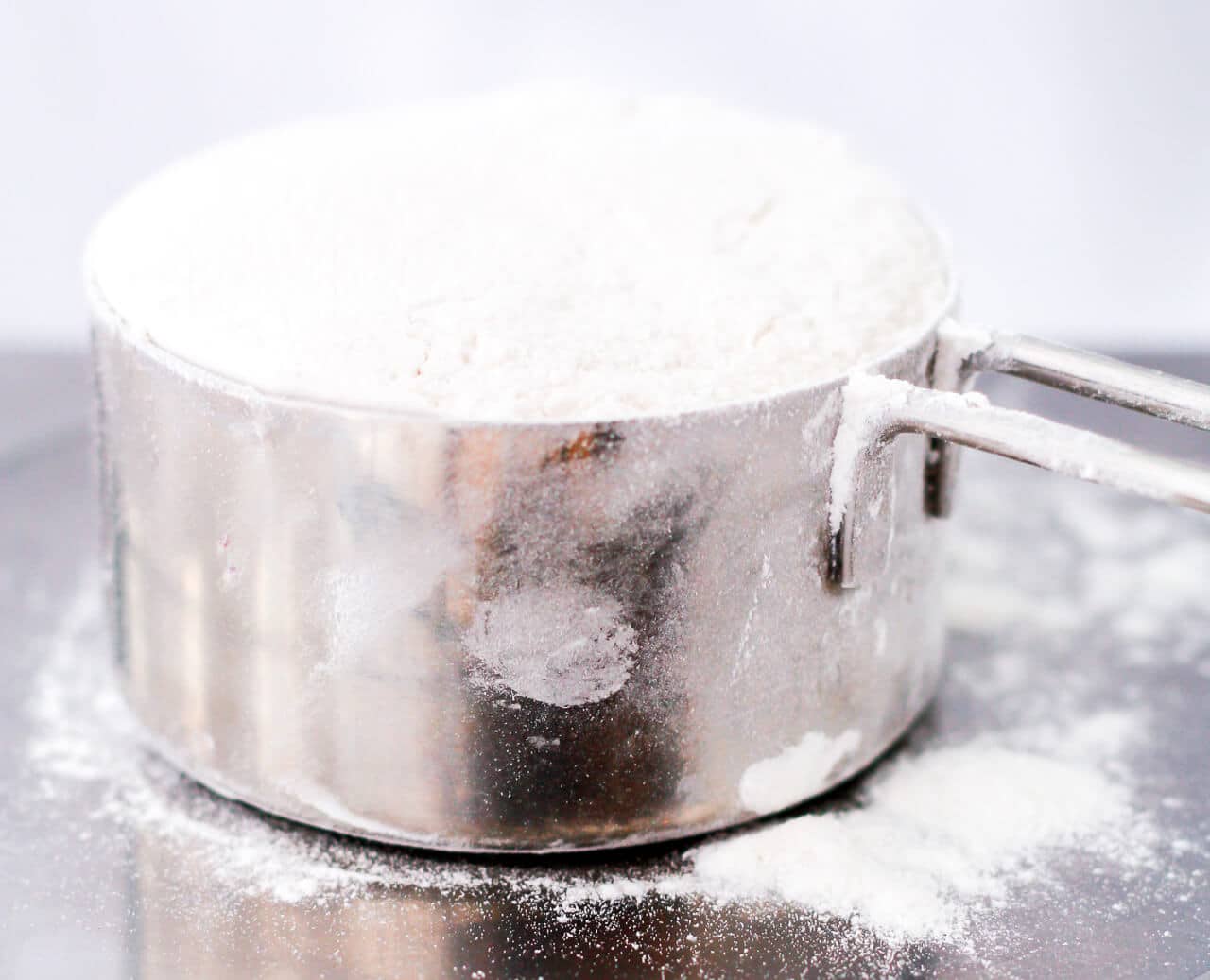
Flour
All-purpose flour is the go-to flour for most bakers and baking recipes. It's hard to beat in that it's high enough in protein that it can be used for bread making, yet it's not so high in protein and can still be used for more tender applications like baking a cake.
It's hard to substitute flours and to replace one with another can literally break a recipe.
Bread flour
Bread flour has the highest protein content of all and some have as much as 16 % protein. That protein adds strength to recipes, which is especially useful when making bread. Bread dough is kneaded to rearrange the proteins and to develop the gluten network, giving bread dough it's strength, it's ability to stretch, its plasticity and its elasticity. The gluten network allows bread dough to trap air bubbles so that bread rises without the air escaping, leading to a more open crumb.
If you don't have bread flour, you can replace it with all-purpose flour, which also has a high protein content, but you cannot use cake or pastry flours in recipes that call for bread flour. That won't work well.
All-purpose flour
All-purpose flour has a fairly high protein content, around 10 % but some Canadian all-purpose flours made from harder wheat may have as much as 12 % protein, which means when you bake with all-purpose, it's likely that more gluten will develop as you stir together your ingredients.
In some cases, you can replace all-purpose with a mixture of cake flour and bread flour, and this is definitely worth a try if you've run out of all-purpose, but you have other flours on hand. Still, don't expect the exact same result with this kind of substitution.
Cake flour
Cake flour has a lower protein content, 7 to 9 % depending on the brand, which leads to less gluten development and so cake flour is great for cakes and other baked goods where you want a more delicate crumb.
If you can't find cake flour, or you've run out, you can bake with all-purpose, replacing it cup-for-cup or with the same amount by weight. Your baked goods may be a little firmer, tougher, or more chewy.
Another option is to make a mixture of all-purpose flour and cornstarch to replace cake flour. Here's how, assuming you are aiming to make cake flour with roughly 8 % protein content and you have an all-purpose flour that is 10 % protein content:
- weigh out 95 grams of all-purpose flour (¾ cup) and add 30 mL (2 tbsp) of cornstarch. This will give you a cake flour substitute with 7.6 % protein. Make sure to triple sift the mixture before using it. You want to make sure that the cornstarch is evenly distributed within the flour to avoid patches of starch in your baked goods. The more you sift the mixture, the better!
Baking with alternative flours
If you want to start baking with alternative flours, a general rule is to only swap out a portion of all-purpose flour for an alternative flour (roughly 25 %). This is the best way to ensure your recipe will turn out well. For example, if your recipe has 1 cup of all-purpose flour, try making it with a mix of 60 mL (¼ cup) alternative flour and 190 mL (¾ cup) all-purpose flour. Going higher than this is risky without further tweaking of the recipe.
If you want to replace all-purpose flour with whole wheat, you can safely replace up to 50 % of all-purpose with whole wheat flour without having too much of an impact on baked goods.
Self-rising flour
This type of flour is very common in UK recipes. Self-rising flour already contains the leavening agent and salt. It's less common in North America
- Replace 1 cup of self-rising flour with 1 cup of all-purpose flour mixed with 7.5 mL (1-½ teaspoons) of baking powder and 1.25 mL (¼ teaspoon) of salt
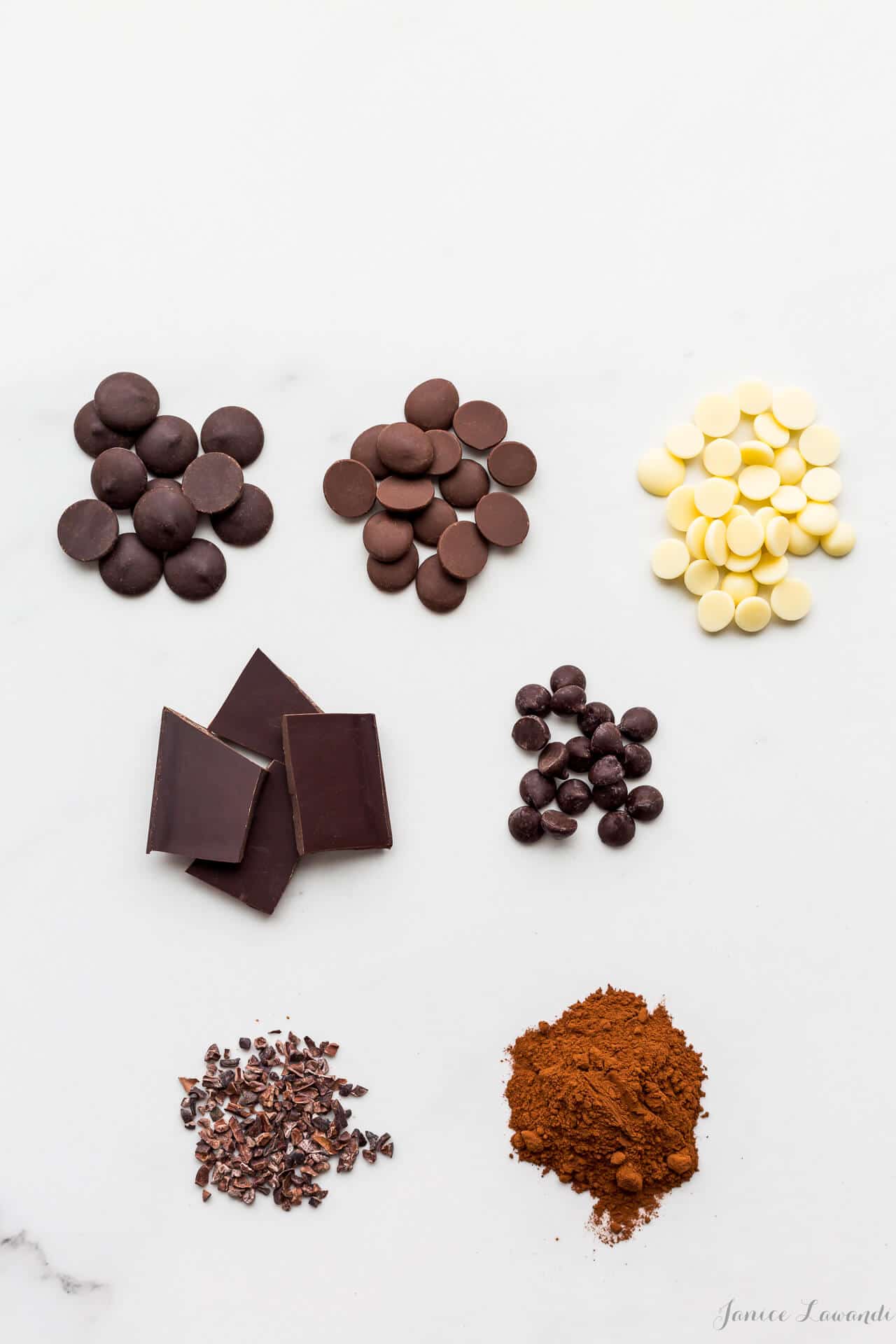
Chocolate
When making substitutions in chocolate recipes, it's important to remember that there are many types of chocolate that you can use for baking. But depending on how the chocolate is used, you can't necessarily replace it with another. For example, this chocolate cake made with dark chocolate can't be made with milk chocolate. These chewy one-bowl brownies can't be made with milk chocolate either. In recipes where the chocolate is melted to incorporate it in a cake batter, cookie batter, pots de crème, or ganache, it's super important to respect the type of chocolate recommended in the recipe to achieve the best results.
On the other hand, in a recipe for cookies, like these chewy oatmeal cookies made with milk chocolate, you can absolutely use dark chocolate, or even white chocolate. In this case, the chocolate is added at the end of the recipe, so you could even replace it with the same volume of raisins if you want!
Cocoa powder and dark chocolate
If you want to substitute cocoa powder with dark chocolate, or chocolate with cocoa powder, it's a little more tricky. Cocoa powder is a dry ingredient, while melted chocolate has more fat (cocoa butter), sugar, and sometimes dairy added too. Replacing cocoa with melted dark chocolate, if you don't compensate for the extra fat and sugar in melted chocolate, you may end up with a more delicate cake, prone to crumbling from the excess fat, and a sweeter baked good. Conversely, if you replace melted dark chocolate with cocoa powder, if you don't add back some extra fat and sugar, you may end up with a dryer product at the end. Here are some guidelines for substituting cocoa and dark chocolate:
- replace 100 g dark chocolate with 56 grams cocoa powder + 44 grams fat (but many will go as low as 22 grams fat)
- replace 56 grams cocoa powder with 100 g dark chocolate + reduce the fat in the recipe too, so take away 20 to 40 g for ever 100 g of dark chocolate added
Cocoa powder versus hot cocoa mix
Let's not forget that cocoa powder is made from chocolate only, with nothing else added. At most, the cocoa may be "dutched," where it is treated with a base in order to raise the pH of the powder, giving it a more pronounced, darker chocolate flavour. On the other hand, hot chocolate mix is made with milk solids, fats, and sugar. You cannot substitute hot cocoa mix in place of cocoa powder without having a huge impact on your baked goods.
Natural vs dutch-process cocoa powder
Another thing to note with cocoa powder is that, while Dutch-process cocoa is basic, meaning pH above 7, natural cocoa powder is acidic, with a pH below 7. This means that when working with a recipe that calls for regular, Dutch-processed cocoa, you can't replace it with natural cocoa, or at least if you do, your baked goods won't be the same.
When baking with natural cocoa powder, you may need to add some baking soda to your recipe to balance out that acidity, especially in brownies and cakes.
Nuts
Whole nuts
- Replace cup-for-cup, meaning substitute 250 mL (1 cup) of almonds for 250 mL (1 cup) of hazelnuts, for example.
Chopped nuts
- Replace cup-for-cup, meaning substitute 250 mL (1 cup) of chopped walnuts for 250 mL (1 cup) of chopped pecans, for example.
Ground nuts
- Replace cup-for-cup, meaning substitute 250 mL (1 cup) of ground almonds for 250 mL (1 cup) of ground pistachios, for example, like in this pistachio baklava recipe.
Orange zest
- Replace 5 mL (1 teaspoon) orange zest with 5 mL (1 teaspoon) lemon zest, grapefruit zest, or lime zest
Salt
Not all salts are the same or rather, you can't replace one salt with the same amount of another. Though most salts are sodium chloride, the amount of sodium per teaspoon varies greatly according to the type of salt. For example, the box of table salt I got at the grocery store has 580 mg sodium per ¼ teaspoon of salt. On the other hand, the box of Diamond Crystal fine kosher salt I use in my baking has 280 mg sodium per ¼ teaspoon of salt. That's half the amount of sodium. For this reason, you have to be very careful when making salt substitutions. For reference:
- Replace 5 mL (1 teaspoon) fine kosher salt with 2.5 mL (½ teaspoon) table salt
- Replace 5 mL (1 teaspoon) table salt with 10 mL (2 teaspoons) fine kosher salt
Vanilla
Vanilla is an essential flavour agent in baking and appears in most recipes in some form or another. You can bake with vanilla beans, vanilla extract, vanilla paste, vanilla powder, among others and the vanilla substitution guidelines vary from brand to brand.
You also have to consider when the vanilla product is added: for example, you have to steep vanilla beans in hot liquid to extract the flavour, while vanilla extract is more delicate and not suitable for heated sauces and custards, unless you add it off the heat. Vanilla extract is better for cakes and cookies.
If you don't have access to any vanilla products, you can replace vanilla extract with:
- a little bourbon, whiskey, or even rum
- some grated tonka bean, which has a floral sweet flavour
- a quarter to half the amount of almond extract (use sparingly because the flavour is strong!)
This guide to baking substitutions and how to replace one ingredient with another in any baking recipe is a good start, but I can't guarantee the results you will get with any substitution. Make sure to take the time to measure your baking ingredients out very carefully and consult the list of baking conversions to make sure you properly convert your recipes from cups to grams, or vice versa.
Some recipes are more sensitive to changes than others and there will be cases where even a seemingly obvious, straightforward ingredient replacement may break a recipe. Though not ideal, it's okay! This is how we learn what to do (and not do) next time!
Need more help with baking conversions?
Most of us aren't born with a natural ability to convert ingredients from cups to grams or ounces. If you would like to learn more about converting recipes from volume to weight measurements, you need the Baking Ingredient conversions chart.
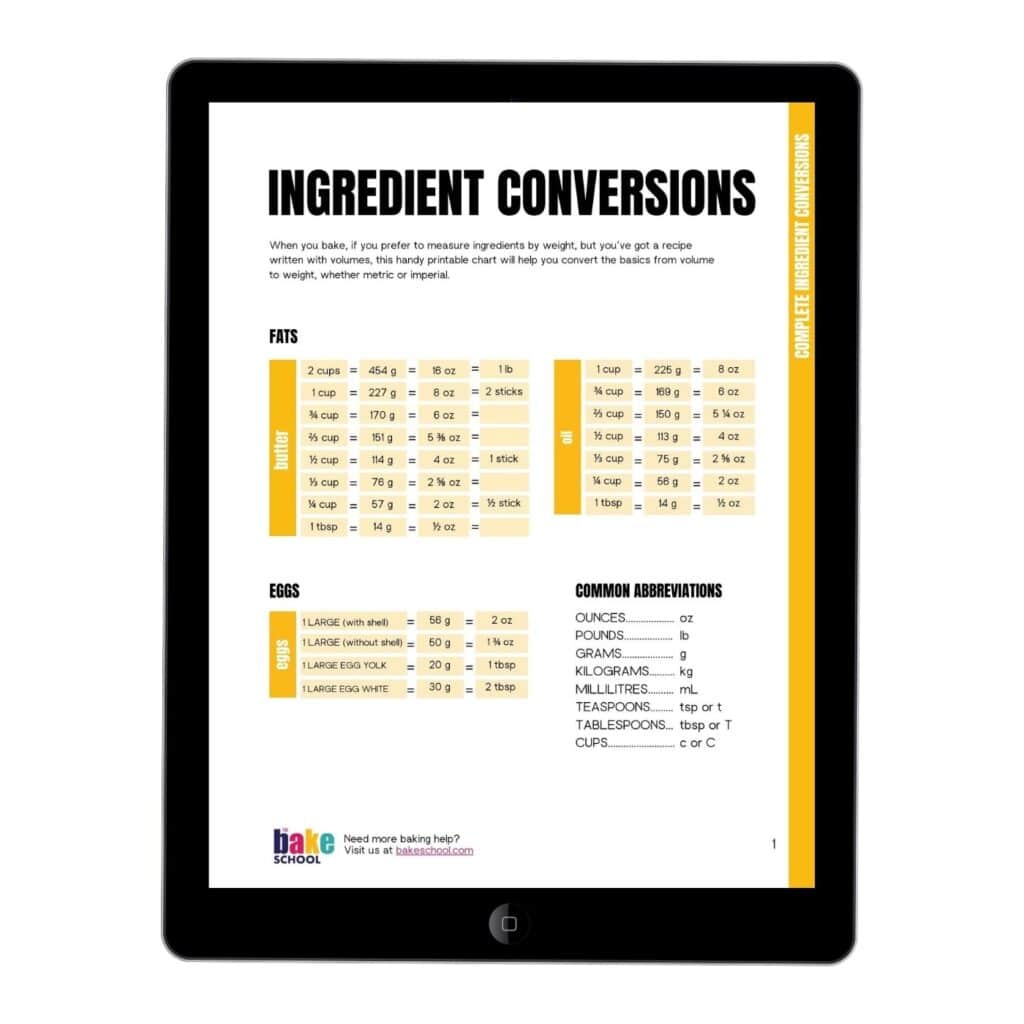
Ingredient conversions chart
Use this baking ingredient converions chart to help you transition from baking by volume to baking by weight. Learn how much one cup of common baking ingredients weigh!

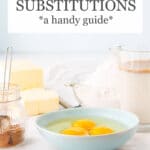
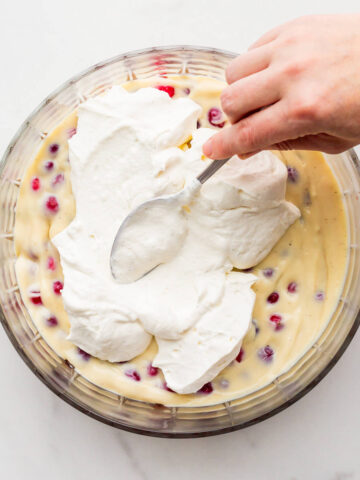
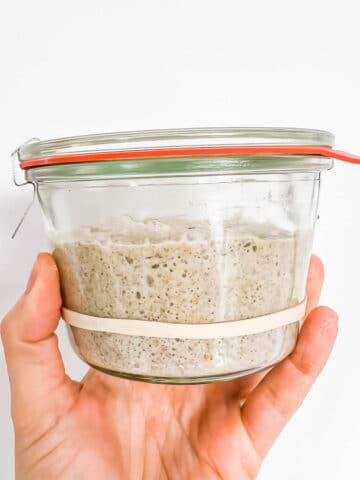


Christina S1 says
Hi. I am interested in replacing table sugar (sucrose) with dextrose (aka corn sugar) to reduce my intake of fructose (sucrose is half fructose) for health reasons. I have tried this in muffins (using 100% of the weight of the flour; dextrose is 30% less sweet than table sugar) and it has worked well, but I am wondering about any advice you may have for using it in cakes, where I imagine it could have more of an impact. I like to bake by weight but unfortunately have not been able to find any cake recipes using dextrose that are measured in grams.
Christina says
Hello,
I want to grind down raw pecans and add this to a basic cookie dough recipe, like chocolate chip dough...would that replace some of the flour or the butter? I know pecans are fatty, and they would not be in a flour-like consistency, more of almost a puree, so I don't know which base ingredient to alter.
Also, this list is very helpful in general, thanks!
Janice says
Hi, I would grind the pecans into a nut flour consistency, similar to ground almonds. Then I’d probably replace a portion of the flour with the ground pecans. If you grind the pecans into a butter, I would still keep the butter, and I’d probably test out adding the nut butter to your favourite chocolate chip cookie to see the impact on the texture. But I still suspect that, if anything, they will replace a portion of the flour, and not necessarily the butter like we might expect. It seems counter-intuitive because, like you said, nuts are quite fatty, but there’s more to them then just the fat, and I think they actually bring a “structural” element to cookies, not just fat.
Sorry I don’t have a specific example right now. I hope this answer may guide you somewhat!